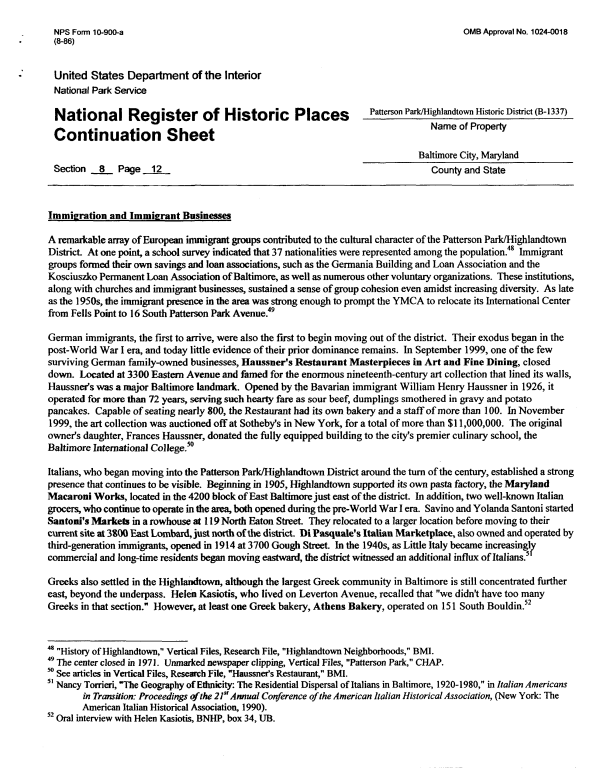 |
||||
|
DEPARTMENT OF HOUSING AND COMMUNITY DEVELOPMENT, MARYLAND HISTORICAL TRUST (Historic Sites Survey) var.d. MSA SE16-3 Image No: se16-3-0107 Enlarge and print image (86K) |
 |
||||
|
DEPARTMENT OF HOUSING AND COMMUNITY DEVELOPMENT, MARYLAND HISTORICAL TRUST (Historic Sites Survey) var.d. MSA SE16-3 Image No: se16-3-0107 Enlarge and print image (86K) |
| NPS Form 1 0-900-a OMB Approval No. 1 024-001 8 (8-86) United States Department of the Interior National Park Service pattern Park/Highiandtown Historic District (B-m?) National Register of Historic Places f* *• -• *»•_ A Name of Property Continuation Sheet Baltimore City, Maryland Section 8 Page 12 County and State Immigration and Immigrant Businesses A remarkable array of European immigrant groups contributed to the cultural character of the Patterson Park/Highlandtown District At one point, a school survey indicated that 37 nationalities were represented among the population.4 Immigrant groups formed their own savings and loan associations, such as the Germania Building and Loan Association and the Kosciuszko Permanent Loan Association of Baltimore, as well as numerous other voluntary organizations. These institutions, along with churches and immigrant businesses, sustained a sense of group cohesion even amidst increasing diversity. As late as the 1950s, the immigrant presence in the area was strong enough to prompt the YMCA to relocate its International Center from Fells Point to 16 South Patterson Park Avenue.49 German immigrants, the first to arrive, were also the first to begin moving out of the district. Their exodus began in the post-World War I era, and today little evidence of their prior dominance remains. In September 1999, one of the few surviving German family-owned businesses, Haussner's Restaurant Masterpieces in Art and Fine Dining, closed down. Located at 3300 Eastern Avenue and famed for the enormous nineteenth-century art collection that lined its walls, Haussner's was a major Baltimore landmark. Opened by the Bavarian immigrant William Henry Haussner in 1926, it operated for more than 72 years, serving such hearty fare as sour beef, dumplings smothered in gravy and potato pancakes. Capable of seating nearly 800, the Restaurant had its own bakery and a staff of more than 100. In November 1999, the art collection was auctioned off at Sotheby's in New York, for a total of more than $11,000,000. The original owner's daughter, Frances Haussner, donated the fully equipped building to the city's premier culinary school, the Baltimore International College.50 Italians, who began moving into the Patterson Park/Highlandtown District around the turn of the century, established a strong presence that continues to be visible. Beginning in 1905, Highlandtown supported its own pasta factory, the Maryland Macaroni Works, located in the 4200 block of East Baltimore just east of the district. In addition, two well-known Italian grocers, who continue to operate in the area, both opened during the pre-World War I era. Savino and Yolanda Santoni started Santoni's Markets in a rowhouse at 119 Norm Eaton Street. They relocated to a larger location before moving to their current site at 3800 East Lombard, just north of the district. Di Pasquale's Italian Marketplace, also owned and operated by third-generation immigrants, opened in 1914 at 3700 Gough Street. In the 1940s, as Little Italy became increasingly commercial and long-time residents began moving eastward, the district witnessed an additional influx of Italians.5 Greeks also settled in the Highlandtown, although the largest Greek community in Baltimore is still concentrated further east, beyond the underpass. Helen Kasiotis, who lived on Leverton Avenue, recalled that "we didn't have too many Greeks in that section." However, at least one Greek bakery, Athens Bakery, operated on 151 South Bouldin.52 48 "History of Highlandtown," Vertical Files, Research File, "Highlandtown Neighborhoods," BMI. 49 The center closed in 1971. Unmarked newspaper clipping, Vertical Files, "Patterson Park," CHAP. 50 See articles in Vertical Files, Research File, "Haussner's Restaurant," BMI. 51 Nancy Torrieri, "The Geography of Ethnicity: The Residential Dispersal of Italians in Baltimore, 1920-1980," in Italian Americans in Transition: Proceeding? of the 21" Annual Conference of the American Italian Historical Association, (New York: The American Italian Historical Association, 1990). 52 Oral interview with Helen Kasiotis, BNHP, box 34, UB. |